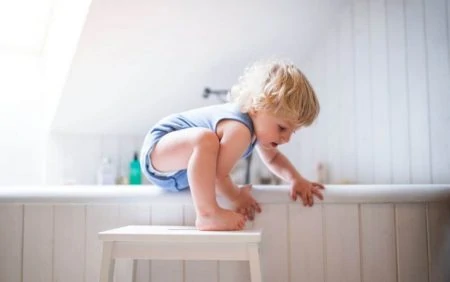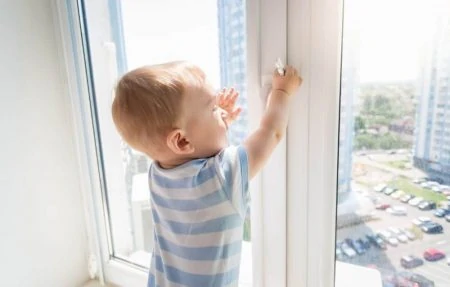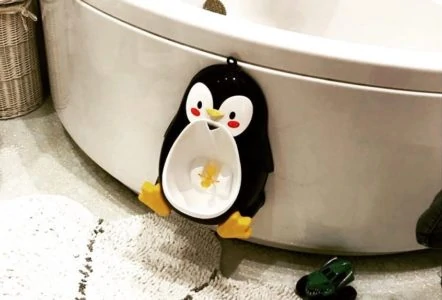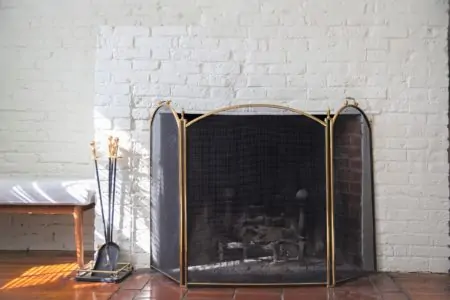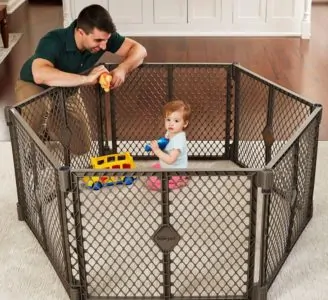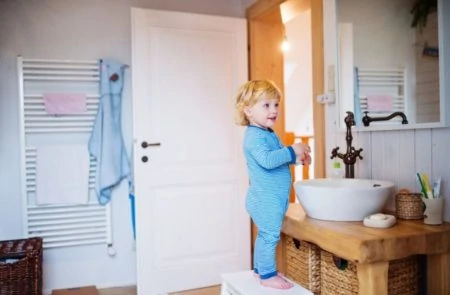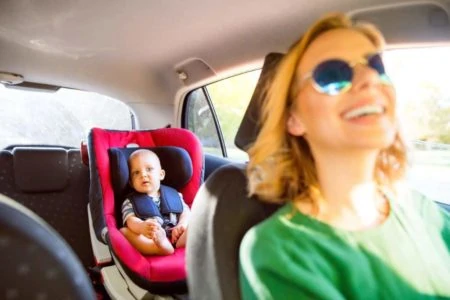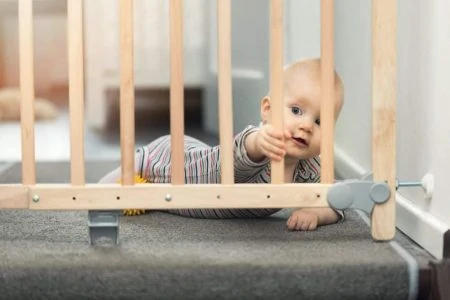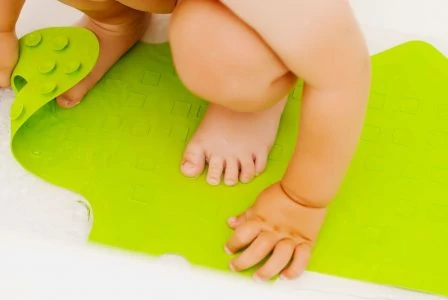Has babyproofing made you see your bathroom in a completely new light? Do you find yourself noticing the slippery surfaces, toxic chemicals, cluttered counters, and all the other potential hazards?
If so, take a deep breath; there are ways to fix this!
We have babyproofed many bathrooms and toilets over the years and have learned to cover all the angles. We will share the essentials for babyproofing your bathroom so you can find peace of mind and keep your baby safe.
What areas should you focus on? Are there products to make it easier? Read on to make sure your bathroom stays a safe place for your little one.
Key Takeaways
- Start early: Babyproof your bathroom before the baby arrives to build good habits and reduce stress.
- Secure the toilet: Use lid locks to prevent drowning risks and handle locks to stop plumbing disasters.
- Bathtub safety: Install non-slip mats, cover the faucet spout, and check water temperature to prevent scalds.
- Lock it up: Keep hazardous items like medicines, cleaners, and razors in locked cabinets out of reach.
When to Babyproof Your Bathroom
Of all the rooms in your house, babyproofing the bathroom might seem like a task you can save for last. After all, your baby won’t be mobile for the first few months, and you can simply shut the door.
However, we strongly encourage parents to address the task of babyproofing before their bundle of joy arrives. Why?
Here are three big reasons to get a head start.
1. You Will Get Busy
Life with a newborn is hectic. You do not want to waste precious mental energy worrying about how your cabinets open or what chemicals are under the sink. If you start early, you will build safer habits before the chaos begins.
2. You Will Perfect Your System
Starting early gives you time to test your setup. The more time you have to perfect your home, the less stress you will experience later. The best way to catch hidden hazards is to take your time.
Go inside the bathroom and sit on the floor to see things from your child’s point of view. This exercise helps you spot dangerous items or sharp corners you might miss from an adult’s height.
3. You Will Learn as You Go
Children are experts at finding trouble in places you least expect. If you have a solid defense in place, you can simply add small safety measures as needed. This is much easier than trying to overhaul the entire room once your baby starts crawling.
We understand that keeping your baby safe is a huge responsibility, but babyproofing does not have to be scary if you tackle it one task at a time.
How to Babyproof Your Toilet
We use our toilets every day without a second thought, but they pose significant risks to curious toddlers. To babyproof your toilet effectively, you need to consider the specific dangers it presents.
Many parents forget that the toilet is a drowning hazard. Children can drown in as little as two inches of water (1). When you add in heavy lids that can crush fingers and easy access to germs, the toilet becomes a major priority.
Here is how to babyproof your toilet in five easy steps.
1. Lock the Door
The most effective way to babyproof your bathroom is to restrict access entirely. Install a lock high up on the outside of the door where your child cannot reach it. There are three common types of locks for this task.
Doorknob Cover
A doorknob cover spins loosely around the knob, preventing little hands from gripping and turning it. To open the door, you must squeeze the cover to grip the knob inside through two holes. This action is usually too complex for toddlers, as their hands are too small to apply the necessary pressure.
If a little one tries to open the door, the cover will simply slip, keeping the door firmly shut.
Safety Chain Locks
Chain locks are affordable and easy to find at any hardware store. They are simple to install and allow you to secure the door from a height your child cannot reach.
Screw the plate into the door and the chain to the frame. The chain slides into the plate to secure it. However, be careful with older children who might try to push through, as they could pinch their fingers.
Barrel Bolt Locks
Barrel bolt locks offer a sturdy solution and minimize the gap where small fingers could get caught.
This lock features a metal rod inside a barrel that slides into a catching chamber on the frame. You must lift and slide the bolt to unlock it, requiring dexterity that most young children lack.
Hook and Eye Locks
A hook and eye lock is the simplest option but also the easiest to defeat. You just place the hook into the eye loop to lock the door. While this works for very young toddlers, older children may eventually figure out how to lift the hook or use force to pop it open.
While locks keep kids out, remember that you need quick access in an emergency. Ensure you have a way to unlock the door from the outside if a child accidentally locks themselves in, or keep the key handy.
Quick Tip
2. Toilet Seat Lock
Children love water, and an open toilet bowl looks like a fun splashing pool to them. Unfortunately, this creates a high risk of drowning and exposure to harmful bacteria.
Heavy ceramic lids can also slam down on small fingers or heads. The easiest solution is a toilet seat lock. These devices secure the lid to the bowl, preventing your child from lifting it. Look for a model that automatically resets when you close the lid so you never forget to lock it.
3. Toilet Paper Holder

If you are tired of walking into a bathroom covered in a mountain of unraveled toilet paper, this simple device is the solution you need.
This holder features a spring-loaded flap that keeps the roll secure. It prevents children and pets from spinning the roll freely, saving you money on wasted paper and preventing plumbing clogs.
It also makes it easy for adults to tear off the right amount of toilet paper with just one hand, which is a nice bonus for busy parents.
TP Safety Tip
4. Toilet Bolt Caps
The bolts that hold your toilet to the floor often have sharp edges or protrude dangerously. Most toilets come with caps, but these small plastic pieces are often loose and can become choking hazards if a child pops them off.
Check that your bolt caps are secure. If your toilet bolts are exposed, you may need to trim them down or purchase child-safe caps that screw on tightly and cannot be easily removed by little fingers.
5. Toilet Handle Lock

Toys, keys, and endless wads of paper often find their way into the toilet when kids are around; prevent expensive plumbing bills by locking the flush handle.
This lock attaches to the tank underneath the handle and acts as a stopper. It prevents the handle from being pushed down until an adult presses the release button. It is a simple, effective way to stop your child from flushing inappropriate items.
How to Babyproof Your Bathtub
Two-thirds of drownings that occur in the home take place in the bathtub. The absolute most important rule is constant adult supervision. Never leave your child unattended in the bath, not even for a second.
Beyond supervision, these safety upgrades can make bath time safer and more enjoyable for everyone.
1. Non-Slip Mat
Bathtubs are incredibly slippery when wet. Place a high-quality non-slip mat on the bottom of your tub to give your child stability. This helps prevent sudden slips and falls, even if your child is just sitting.
You can choose a full-length bath mat or individual non-slip stickers. Stickers can be a fun option as they often come in colorful shapes and animals that kids love.
Bath Mat Tip
2. Spout Cover

The metal faucet spout sticks out right at head-level for a toddler, creating a risk for painful bumps and bruises during bath time play.
A spout cover is a soft rubber or silicone guard that fits over the metal faucet. It absorbs the impact if your child bumps their head, preventing tears and injuries. Plus, many come in cute animal designs that add to the fun.
3. Tub Separator
A tub separator creates a smaller, contained space within your full-sized bathtub. This saves water and keeps your baby within arm’s reach.
By reducing the amount of space your baby can move around in, you prevent them from slipping toward the far end of the tub. It also creates a barrier that can stop toys from floating away, keeping your little one focused and calm.
4. Bathing Seat

Transitioning from a baby tub to a big tub can be slippery business; a bathing seat helps support your infant while allowing them to enjoy the water.
These seats help keep your baby in an upright position, which is helpful for washing. However, please remember that **a bath seat is not a safety device**. It does not prevent drowning. You must stay right next to the tub with your eyes on your baby at all times.
Always check the weight and age limits on the specific seat you buy to ensure it is appropriate for your child.
5. Bath Organizer

Loose bottles and toys on the bathtub ledge are just asking to be grabbed, spilled, or tripped over; keep the chaos contained with a dedicated organizer.
A scoop-style organizer allows you to quickly gather up bath toys and hang them up to dry. Look for mesh or slotted designs that allow water to drain out, preventing mold growth on your child’s favorite rubber duckies.
Pro Tip
Babyproofing Your Bathroom Cabinets
Children are naturally curious explorers. If your bathroom cabinets are accessible, they will find hair tools, toxic cleaning supplies, and medications.
Follow these instructions to babyproof your cabinets effectively.
- Remove hazards: Move all hazardous materials, including cleaners and medicines, to a high shelf or cabinet. Never rely solely on a cabinet lock for highly toxic items.
- Audit items: You do not need to lock every single drawer. You can leave cabinets with safe items like towels, washcloths, or unopened toilet paper unlocked. This gives your child a “safe” space to explore while you get ready.
- Purchase locks: Install cabinet locks on all doors containing dangerous items. Popular options include magnetic locks (invisible from the outside), sliding locks, and cord locks.
The goal is to keep dangerous items out of little hands while maintaining easy access for adults.
Babyproofing Your Bathroom Counter
Do you keep toiletries scattered on the counter? If so, it is time to reorganize. Items left on the counter are tempting targets for climbing toddlers.
Clear the clutter and store items in drawers. Here are a few specific hazards to watch out for.
1. Hairstyling Tools
Curling irons and straighteners get extremely hot and can cause severe burns. Never leave them unattended while cooling down. A child can easily pull on a dangling cord and bring the hot iron down onto themselves. Store them in a heat-proof mat or high cabinet immediately after use.
2. Corner Guards
Stone or ceramic countertops often have sharp edges. As your child grows and their head reaches counter height, a slip could result in a nasty gash. Apply silicone corner guards to the sharpest edges to soften any potential impact.
3. Remove Climbing Aids
Toddlers love to climb. Remove step stools when they are not in use. If a child climbs onto the toilet or a stool, they can reach dangerous items on the counter or fall onto the hard tile floor.
Extra Babyproofing Bathroom Tips
Want to go the extra mile? Pay attention to these small details to create an even safer environment.
- Toilet brush: Toilet brushes are teeming with bacteria. Store your brush in a locked cabinet or on a high shelf where your child cannot try to play with (or taste) it.
- Shower curtains: Heavy curtains can be pulled down. Ensure your rod is securely tensioned or screwed into the wall. Use breathable materials like nylon to prevent mold buildup.
- Water temperature: Set your home’s water heater to 120 degrees Fahrenheit (49 degrees Celsius) to prevent accidental scalding. Always use a bath thermometer to check the water before putting your baby in; the ideal bath temperature is around 100 degrees Fahrenheit (38 degrees Celsius).
- Garbage cans: Bathroom trash often contains hazardous items like razors, batteries, or old medicine. Use a trash can with a locking lid or store a small bin inside a locked cabinet to keep your child away from germs and sharp objects.
Teaching Bathroom Etiquette
Babyproofing is essential, but teaching your child boundaries is just as important. Explain why certain items are “no-touch” zones.
This is especially crucial during potty training. You want your child to feel comfortable in the bathroom, not scared. Create a safe, welcoming environment by using child-friendly decor and ensuring they have access to their potty chair and hand-washing station while keeping the dangerous stuff out of reach.
FAQs
Your Bathroom Babyproofing Tips
By following these tips, you will be well on your way to having a safe yet functional bathroom for your entire family.
Babyproofing the bathroom can feel overwhelming, but you do not have to do it all in one day. Start with the biggest hazards, like the toilet and chemical storage, and work your way down the list. A little prevention now brings a lot of peace of mind later.
